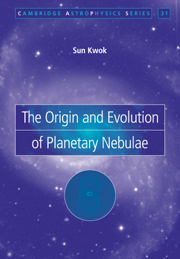Book contents
- Frontmatter
- Contents
- Preface
- 1 History and overview
- 2 Ionization structure of planetary nebulae
- 3 Nebular line radiation
- 4 Nebular continuum radiation
- 5 The neutral gas component
- 6 The dust component
- 7 Observations of the central star of planetary nebulae
- 8 Morphologies of planetary nebulae
- 9 Problems and questions
- 10 Asymptotic giant branch stars – progenitors of planetary nebulae
- 11 Evolution of the central stars
- 12 Formation of planetary nebulae
- 13 Dynamical evolution of planetary nebulae
- 14 Protoplanetary nebulae – the transition objects
- 15 Evolution to the white dwarf stage
- 16 Distances to planetary nebulae
- 17 Comparison between evolutionary models and observations
- 18 PN in the galactic context
- 19 Chemical abundances
- 20 Planetary nebulae in other galaxies
- 21 Concluding remarks
- References
- Appendix List of symbols and abbreviations
- Subject index
15 - Evolution to the white dwarf stage
Published online by Cambridge University Press: 04 November 2009
- Frontmatter
- Contents
- Preface
- 1 History and overview
- 2 Ionization structure of planetary nebulae
- 3 Nebular line radiation
- 4 Nebular continuum radiation
- 5 The neutral gas component
- 6 The dust component
- 7 Observations of the central star of planetary nebulae
- 8 Morphologies of planetary nebulae
- 9 Problems and questions
- 10 Asymptotic giant branch stars – progenitors of planetary nebulae
- 11 Evolution of the central stars
- 12 Formation of planetary nebulae
- 13 Dynamical evolution of planetary nebulae
- 14 Protoplanetary nebulae – the transition objects
- 15 Evolution to the white dwarf stage
- 16 Distances to planetary nebulae
- 17 Comparison between evolutionary models and observations
- 18 PN in the galactic context
- 19 Chemical abundances
- 20 Planetary nebulae in other galaxies
- 21 Concluding remarks
- References
- Appendix List of symbols and abbreviations
- Subject index
Summary
In Chapter 11 we discussed that the central stars of PN originate from the electrondegenerate carbon-oxygen core of AGB stars. After the thin H envelope has been depleted by nuclear burning and mass loss, CSPN will change from deriving their energies from the CNO process to gravitational contraction. This is accompanied by a drop in luminosity by at least an order of magnitude. He burning is unimportant (except during a thermal pulse) and also dies away eventually. The star now enters the “cooling track” with a gradual decline in both luminosity and temperature. These blue and faint stars are referred to as white dwarfs (WDs).
WDs were discovered as faint stars that are unusually dense that perturb the orbits of their normal companions through gravitational interaction. Most of the early WD discoveries are nearby single stars, which are found in surveys of stars with large proper motions (Luyten, 1979). More recent discoveries have resulted from surveys of faint blue stars, such as the quasar survey of Palomar-Green (Green et al., 1986). The PG survey has led to the discovery of hot, H-deficient stars known as PG 1159 stars (see Section 7.3). These are the hottest WDs and therefore can be considered as possible transition objects between the PN and WD stages.
For very low-mass stars, it is possible that mass loss or binary mass transfer on the RGB removes sufficient mass from the envelope to stop nuclear evolution before the He flash.
- Type
- Chapter
- Information
- The Origin and Evolution of Planetary Nebulae , pp. 167 - 176Publisher: Cambridge University PressPrint publication year: 2000



